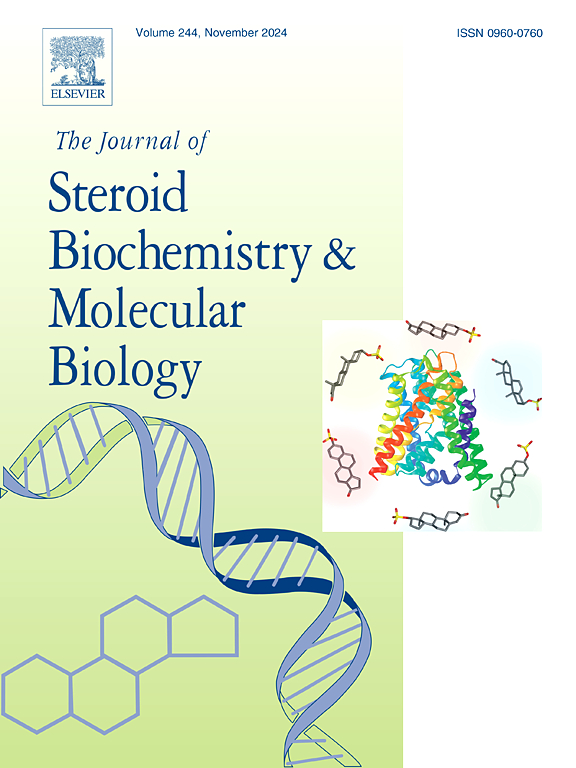网络药理学引导的系统生物学揭示了β-谷甾醇在逆转7-酮胆固醇诱导的氧化和炎症应激中的多靶点作用
IF 2.5
2区 生物学
Q3 BIOCHEMISTRY & MOLECULAR BIOLOGY
Journal of Steroid Biochemistry and Molecular Biology
Pub Date : 2025-09-12
DOI:10.1016/j.jsbmb.2025.106863
引用次数: 0
摘要
7-酮胆固醇(7-KC)是一种通过胆固醇氧化产生的细胞毒性氧固醇,通过线粒体功能障碍、ROS过度产生和NLRP3炎性体激活,在动脉粥样硬化、神经变性和代谢综合征的进展中起核心作用。本研究首次通过综合系统药理学分析,探索具有抗氧化和抗炎特性的植物甾醇β-谷甾醇(BS)减轻7kc诱导的毒性的分子机制。通过目标预测数据库确定BS和7KC之间的共享靶点,并使用具有瓶颈中心性的Cytoscape进行蛋白相互作用(PPI)网络分析。利用Gene Ontology和KEGG通路工具对顶部枢纽基因进行功能富集,揭示了BS对核受体活性、氧化还原稳态和OXPHOS通路的调节。BS靶点定位于细胞质、细胞核和膜室,支持其多室调节作用。这一机制框架强调了BS作为7kc驱动的慢性疾病(包括动脉粥样硬化、NAFLD和阿尔茨海默病)的潜在营养干预措施,需要进一步的生物学验证。本文章由计算机程序翻译,如有差异,请以英文原文为准。
Network pharmacology-guided systems biology reveals β-Sitosterol’s multi-target role in reversing 7-ketocholesterol-induced oxidative and inflammatory stress
7-Ketocholesterol (7-KC), a cytotoxic oxysterol generated through cholesterol oxidation, plays a central role in the progression of atherosclerosis, neurodegeneration, and metabolic syndromes through mitochondrial dysfunction, ROS overproduction, and NLRP3 inflammasome activation. This study presents the first integrative systems pharmacology analysis exploring the molecular mechanisms by which β-sitosterol (BS), a phytosterol with antioxidant and anti-inflammatory properties, mitigates 7KC-induced toxicity. Shared targets between BS and 7KC were identified through target prediction databases and subjected to protein–protein interaction (PPI) network analysis using Cytoscape with bottleneck centrality. Top hub genes were functionally enriched using Gene Ontology and KEGG pathway tools, revealing BS’s modulation of nuclear receptor activity, redox homeostasis, and OXPHOS pathways. BS targets were localized across cytosol, nucleus, and membrane compartments, supporting its multi-compartmental regulatory role. This mechanistic framework highlights BS as a potential nutraceutical intervention for 7KC-driven chronic diseases, including atherosclerosis, NAFLD, and Alzheimer’s disease, warranting further biological validation.
求助全文
通过发布文献求助,成功后即可免费获取论文全文。
去求助
来源期刊
CiteScore
8.60
自引率
2.40%
发文量
113
审稿时长
46 days
期刊介绍:
The Journal of Steroid Biochemistry and Molecular Biology is devoted to new experimental and theoretical developments in areas related to steroids including vitamin D, lipids and their metabolomics. The Journal publishes a variety of contributions, including original articles, general and focused reviews, and rapid communications (brief articles of particular interest and clear novelty). Selected cutting-edge topics will be addressed in Special Issues managed by Guest Editors. Special Issues will contain both commissioned reviews and original research papers to provide comprehensive coverage of specific topics, and all submissions will undergo rigorous peer-review prior to publication.

 求助内容:
求助内容: 应助结果提醒方式:
应助结果提醒方式:


